Genre: Action Developer: Shin-Nihon Laser Soft Co. Publisher: Renovation Players: 1 Released: 1991
Renovation. Love ’em or hate ’em. Genesis owners know their name, and we played their games. They were one of the early contributors to the Genesis camp back in the early years of the system, publishing titles from such development teams like Wolfteam and Telenet Japan. But they were one of those companies that either gave us games that were really good (El Viento, Gaiares), somewhat okay (Earnest Evans) or just downright pitiful (Beast Wrestler). But today’s subject is that of one particular game Renovation brought to the U.S. in the early ’90s: Valis III.
Valis III is, of course, the third game in the Mugen Senshi Valis (or just Valis) series, which has its roots in the MSX and PC-8801 series of computers in Japan. The games focus on a young woman named Yuko, who is the Valis Warrior and Anime Babe Extraordinaire. She is the wielder of the Valis sword and the chosen warrior of the kingdom of Dreamland (no, Kirby fans, not that Dreamland). In this particular chapter, the Dark World is on the verge of collapse from falling into the Netherealm, and Glames, a black-hearted General from the Dark World, decides it prime time to move himself and his minions into the Dreamland and Earth. Meanwhile, a young girl from the Dark World, Cham, has come to Earth in desperate search of the Valis sword. Cham manages to steal the sword away from Yuko and runs off into the night, with Yuko hot on her heels. Cham is quickly snatched up by one of Glames’ henchmen, and when Yuko saves her, Cham tells her of Glames and his plan to conquer Earth and Dreamland. She also explains that Yuko’s sister, Valna, was captured by Glames and imprisoned in crystal. Yuko and Cham set off to free Valna together, and upon releasing her from her prison find out that Yuko must strengthen her sword to combat the Leethus sword, held by Glames himself.
Valis III improves several aspects of Valis I and II, first and foremost of which is the inclusion of multiple playable characters. At first Yuko is only playable, but once Cham and Valna are rescued they will become playable as well. The girls all have different strengths and weaknesses and are pretty unique for the game. Yuko uses her Valis sword primarily and has a good short to mid-range attack, but her magic is rather weak. Likewise, Valna has great range but weak attacks, and her magic is by far the best of the three. Cham, however, has excellent strength and great range with her whip, plus she’s the only character who doesn’t lose strength or speed between attacks, but her magic is only so-so. There will be certain points that you will be forced to either choose a character or use one only (such as the boat ride to the prison or when Valna is freed from prison that she must fight the stage boss alone), but for the most part you won’t experience too much trouble with any character. You can grab three different types of magic (red, white, and blue), each of which works differently in different hands.
There’s also the new attack bar, shown as a sword on the status bar. This fills between attacks and drops each time you execute an attack. This means that you can’t exactly rapidly attack with anybody, since their attacks will be too weak every time. But let the bar fill up, and you can cause better damage with each attack. You can also find power-ups to lengthen the bar, thereby causing more damage but having to wait longer between attacks for max power unless you find a power up that’ll give you maximum power with every attack.
Valis III takes you through nine stages from Earth all the way to the Dark World, and finally into Glames’ stronghold. Each stage is quite long and broken down into several sub-stages, which get progressively harder and harder until you’re thrown into stages that get to be near impossible. Not impossible like “Ninja Gaiden‘s Act 6-2″ impossible, but more like “that stupid pit walk from TMNT for the NES” impossible. There are lots of crazy little things in stages that can trip you up or catch you off guard, like the flowing water in the temple stages or the jumps needed in the ice cavern stage, and those are most attributed to the slightly sluggish control. It’s not that the control is BAD, per se, but it’s sort of Castlevania-like in its execution: there’s considerable lag sometimes between hitting the button and the action onscreen. Plus, none of the girls jump very high at all, and in order to super jump you have to hit both Up on the D-Pad as well as the B button. The only downside to this is that it doesn’t always respond, resulting in some cheap deaths. At least combat is more responsive, but there will still be cases that enemies can (and will) swarm you and make your life a living hell.
Graphically, Valis III comes through rather well. Although not as sharp looking or as colorful as the Turbo Grafx CD version, it looks great for the Genesis. Enemies are nicely detailed and animated, as are the ladies. There’s also nice use of parallax on the backgrounds, and the variety of environments is put to good use. But what is it that makes the game stand out? Yep, it’s the cut scenes! Back in a day where plot played second fiddle to the game itself, it’s amazing to see animated cut scenes in a game like this, and they remind me of Ninja Gaiden in their execution. The artwork in the cut scenes is wonderful and compliments the game perfectly. As I said before, Yuko is Anime Babe Extraordinaire, and if the cut scenes don’t say otherwise, what will? On the audio side of things, the sounds are okay but kind of muffled, but the music is pretty good. The tunes have a good pace (and there are plenty of tunes, too!) and compliment the action like chili on a hot dog. Although the music sounds fine on the Genesis, it pales in comparison to the CD remixes on the Turbo CD.
Although a bit of an obscure game, Valis III deserves at least one playthrough from any respectable Genesis owner. It’s a little uncommon to see nowadays, but if you ever do come across it, go for it. You’ll get to at least see part of a series that was one of the prime picks of the 16-bit days.
SCORE: 8 out of 10


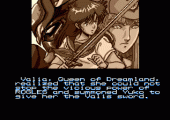
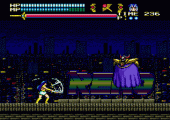
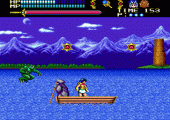
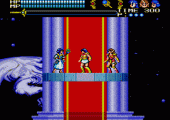
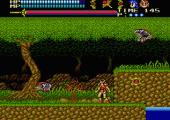
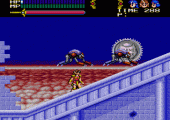
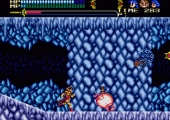
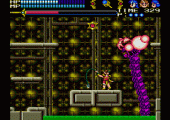
Recent Comments